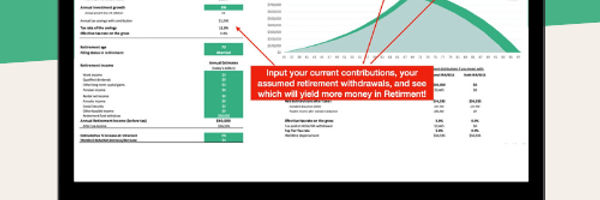In this article, we're going to talk about Roth IRA conversions. That discussion will include Roth IRA contribution rules, transfers, income limits for conversions, and their affect on income taxes owed. We'll also discuss when, and under what conditions, it might be a good idea to make a conversion.

Roth IRA or 401k? This template will answer your questions.
With this template, you will get:
All DFY, simply add your details
Charts for comparison and clear answer
Easily update for any year (2023, 2024, 2025, etc…)

Managing Roth and Traditional IRA Accounts
When the Roth IRA was first introduced, many investors quickly switched their retirement funding strategy from Traditional IRAs to Roth IRAs. Since many higher income individuals were already making after-tax contributions to a Traditional IRA, the switch to a Roth was a good investment decision.
Additional Resources |
Instead of paying federal income taxes on the growth portion of their IRA's after-tax contributions, investors could now make an after-tax contribution to a Roth IRA, and not pay any taxes on their withdrawals in retirement. While the benefits of the Roth were clear enough going forward, individuals planning for their retirement years didn't think twice about managing two accounts: one for their Traditional IRAs, and a second one for their Roth accounts.
Roth IRA Contributions
Let's quickly review the concept of Roth IRA contributions. After all, a Roth conversion is just one of several ways it's possible to contribute to a Roth IRA plan.
At the most basic level, anyone that has earned income, and pays income taxes, can contribute to a Roth IRA regardless of their age. Unlike a Traditional IRA, individuals can still contribute to a Roth after age 70 1/2. In fact, if someone wants to make a contribution to a Roth IRA via a conversion, they don't even need to have earned income. But there is an important income limitation that applies to conversions.
Conversion Rules
Generally, there are three ways the IRS recognizes conversions from Traditional to Roth IRAs:
Rollovers: an IRA rollover is basically an eligible distribution from a Traditional IRA that is rolled-over into a Roth IRA within 60 days after the distribution.
Same-Trustee Transfers: if the IRA trustee for the Traditional IRA is the same trustee as the Roth, then that trustee (in many cases a brokerage house) can make the transfer on the accountholder's behalf.
Trustee-to-Trustee Transfers: many times a Traditional IRA trustee will make a transfer to a new Roth IRA trustee on the accountholder's behalf; even if they are not the trustee receiving the funds.
Keep in mind that if the accountholder takes a distribution from a Traditional IRA, the 60-day rollover rule applies. If at all possible, convert the Roth IRA using a trustee-to-trustee transfer or same-trustee transfer. This approach keeps clear of the 60-day rule, and keeps the money working longer.
Conversion Income Limits
The IRS rules state that if an accountholder wants to convert from a Traditional IRA to a Roth IRA, their modified adjusted gross income or AGI cannot be greater than $100,000. This limit applies to taxpayers with filing statuses of single, head of household, and married filing jointly. Married taxpayers filing separate returns are explicitly excluded from making Roth conversions.
Reversing a Conversion
If an accountholder makes a Roth conversion early in a calendar year, and then for some reason discovers their AGI will exceed the $100,000 threshold, the tax law allows them to "re-characterize" their Roth, and have the money rolled-back into a regular IRA without a penalty. There are just a few simple steps to follow before filing a federal income tax return for that year.
Tax Implications of Roth Conversions
While the Roth conversion amount is NOT included in the AGI calculation to determine eligibility to convert, it may affect AGI when calculating income taxes owed the federal government. That's because it's possible to contribute to a Traditional IRA with both non-deductible funds as well as tax-deductible funds.
The rule of thumb here is pretty simple: If the accountholder has paid federal income tax on any portion of their Traditional IRA, they don't need to include that amount again in their AGI following a conversion. Let's look at a quick example of how that would work.
Roth IRA Conversion Example
Let's say that Jon decides to convert his Traditional IRA to a Roth. Jon expects that his AGI will be about $85,000 in that calendar year, and he wants to convert around $40,000 of tax deductible Traditional IRA funds (money he has never paid federal income tax on before).
Since Jon's original AGI is under the $100,000 threshold, he can do the conversion. However, when calculating his tax liability for that year, Jon's AGI is now $85,000 + $40,000, or $125,000. If Jon's incremental tax bracket is 25%, then he will need to pay an additional 25% x $40,000 or $10,000 in federal income taxes the year of the conversion.
Please note that in the above example, Jon did not have to pay a 10% early withdrawal penalty on the conversion. However, with large conversions it's advisable to consult with a tax professional to see if the paying of estimated taxes is appropriate. In some states, taxpayers may also be subject to additional state income taxes on the conversion.
Paying Taxes with Converted IRA Funds
Finally, there is a common misconception that some of the converted money can be used to pay for any federal taxes owed. For example, let's say Jon doesn't have the funds to pay the $10,000 in federal taxes owed on the conversion, so he decides to use $10,000 of the Traditional IRA money to pay federal taxes owed. If he does, this is characterized as an early distribution of the money, $10,000 in this situation. Any money not converted is subject to early withdrawal penalties, including this same money Jon wants to use to pay his federal income taxes.
About the Author - Roth IRA Conversions



.jpg)
.jpg)